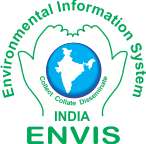|
 |
Sahyadri ENews: LXIX
HYDRO-ECOLOGICAL FOOTPRINT OF SHARAVATHI RIVER BASIN
|
 |
Issues:
1
2
3
4
5
6
7
8
9
10
11
12
13
14
15
16
17
18
19
20
21
22
23
24
25
26
27
28
29
30
31
32
33
34
35
36
37
38
39
40
41
42
43
44
45
46
47
48
49
50
51
52
53
54
55
56
57
58
59
60
61
62
63
64
65
66
67
68
HYDRO-ECOLOGICAL FOOTPRINT OF SHARAVATHI RIVER BASIN
(PDF)
Vinay. S1,2, Bharath, S1, Chndran, M. D. S1,Bharath, H. A1,3, Shashishankar, A2,4, Ramachandra. T. V1
1Energy and Wetlands Research Group, Centre for Ecological Sciences, Indian Institute of Science, Bangalore
2Visvesvaraya Technological University, Belgaum
3RCGSIDM, IIT Kharagpur, Kharagpur
4AMC Engineering College, Bannerghatta Road, Bangalore
7. References
- M. Acreman, “Environmental flows-basics for novices,” Interdiscip. Rev. Water, vol. 3, no. 5, pp. 622–628, Sep. 2016.
- W. Liu, X. Wei, H. Fan, X. Guo, Y. Liu, M. Zhang, and Q. Li, “Response of flow regimes to deforestation and reforestation in a rain-dominated large watershed of subtropical China,” Hydrol. Process., vol. 29, no. 24, pp. 5003–5015, 2015.
- N. L. Poff, J. D. Allan, M. B. Bain, J. R. Karr, K. L. Prestegaard, B. D. Richter, R. E. Sparks, and J. C. Stromberg, “The Natural Flow Regime: A paradigm for river conservation and restoration.,” Bioscience, vol. 47, no. 11, pp. 769–784, 1997.
- T. Russo, M. Eineman, and E. DiMaggio, “Water: Science and Society,” Pennsylvania State University-University Park Penn State World Campus. [Online]. Available: https://www.e-education.psu.edu/earth111/. [Accessed: 02-Jun-2018].
- B. D. Richter, J. V Baumgartner, J. Powell, and D. P. Braun, “A Method for Assessing Hydrologic Alteration within Ecosystems,” Conserv. Biol., vol. 10, no. 4, pp. 1163–1174, 1996.
- S. E. Bunn and A. H. Arthington, “Basic principles and ecological consequences of altered flow regimes for aquatic biodiversity,” Environmental Management, vol. 30, no. 4. pp. 492–507, 2002.
- R. R. Iyer, “The notion of environmental flows: a caution,” in NIE/IWMI Workshop on Environmental Flows, 2005.
- M. Dyson, G. Bergkamp, and J. Scanlon, Eds., Flow – The essentials of environmental flows, 2nd ed. Switzerland: IUCN, 2013.
- T. V. Ramachandra, M. D. S. Chandran, S. Vinay, P. B. Sudarshan, D. M. Vishnu, G. R. Rao, N. Shrikanth, and H. A. Bharath, “Sacred Groves (Kan forests) of Sagara taluk, Shimoga district,” Sahyadri Conservation Series: 54, ENVIS Technical Report 102, Bangalore 560 012, 2016.
- S. Vinay, D. M. Vishnu, N. Srikanth, K. S. Asulabha, V. Sincy, G. R. Rao, A. Shashishankar, M. D. S. Chandran, and T. V Ramachandra, “Hydrological regime in Sacred Groves and NonSacred Groves of Central Western Ghats,” in Lake 2016 : Conference on Conservation and Sustainable Management of Ecologically Sensitive Regions in Western Ghats, 2016.
- S. C. Schneider and Z. Petrin, “Effects of flow regime on benthic algae and macroinvertebrates - A comparison between regulated and unregulated rivers,” Sci. Total Environ., vol. 579, pp. 1059–1072, 2017.
- “Ministry of Environment, Forest and Climate Change,” Government of India, 2013. [Online]. Available: http://www.moef.nic.in/. [Accessed: 09-Nov-2013].
- D. K. Subramanian, “A framework for conducting carrying capacity studies for Dakshina kannada district,” Bangalore, 1998.
- W. Ji, “Dynamic analysis of ecological footprint and ecological carrying capacity,” in 2010 Sixth International Conference on Natural Computation, 2010, pp. 3033–3036.
- UNESCO, “Water for a sustaibale world,” United Nations, 2015.
- T. V Ramachandra, S. Bharath, G. Nimish, and R. S. Bhargavi, “Monitoring forest dynamics within and buffer regions of protected areas in Karnataka,” Bangalore 560 012, 2017.
- T. V. Ramachandra, S. Bharath, and M. D. S. Chandran, “Geospatial analysis of forest fragmentation in Uttara Kannada District, India,” For. Ecosyst., vol. 3, no. 1, p. 10, 2016.
- T. V. Ramachandra, S. Bharath, M. D. S. Chandran, Vishnumayananda, R. B. Harish, G. R. Rao, C. A. Akhil, D. M. Vishnu, S. Chathurved, K. Gouri, and H. A. Bharath, “Ecologically Sensitive Zones of Bannerghatta National Park (BNP),” Sahyadri Concervation Series 57, ENVIS Technical Report 109, Bangalore 560 012, 2016.
- K. Vijay and T. V. Ramachandra, Environmental Management. Bangalore 560 012: The Energy and Resources Institute (TERI), 2006.
- E. B. Santoso, H. K. D. M. Erli, B. U. Aulia, and A. Ghozali, “Concept of Carrying Capacity: Challenges in Spatial Planning (Case Study of East Java Province, Indonesia),” Procedia - Soc. Behav. Sci., vol. 135, pp. 130–135, 2014.
- J. T. Peterson and T. J. Kwak, “Modeling the effects of land use and climate change on riverine smallmouth bass,” Ecol. Appl., vol. 9, no. 4, pp. 1391–1404, 1999.cv
- M. H. Costa, A. Botta, and J. A. Cardille, “Effects of large-scale changes in land cover on the discharge of the Tocantins River, Southeastern Amazonia,” J. Hydrol., vol. 283, no. 1–4, pp. 206–217, 2003.
- N. S. Debortoli, V. Dubreuil, M. Hirota, S. R. Filho, D. P. Lindoso, and J. Nabucet, “Detecting deforestation impacts in Southern Amazonia rainfall using rain gauges,” Int. J. Climatol., vol. 37, no. 6, pp. 2889–2900, 2017.
- A. E. Brown, L. Zhang, T. A. McMahon, A. W. Western, and R. A. Vertessy, “A review of paired catchment studies for determining changes in water yield resulting from alterations in vegetation,” Journal of Hydrology, vol. 310, no. 1–4. pp. 28–61, 2005.
- B. X. Dung, T. Gomi, S. Miyata, and R. C. Sidle, “Peak flow responses and recession flow characteristics after thinning of Japanese cypress forest in a headwater catchment,” Hydrol. Res. Lett., vol. 6, pp. 35–40, 2012.
- R. A. Vertessy, F. G. R. Watson, and S. K. O’Sullivan, “Factors determining relations between stand age and catchment water balance in mountain ash forests,” in Forest Ecology and Management, 2001, vol. 143, no. 1–3, pp. 13–26.
- T. V. Ramachnadra, S. Vinay, S. Bharath, and H. A. Bharath, “Profile of rivers in Karnataka,” ENVIS Technical Report 129, Bangalore, 2017.
- Department of Science & Technology, “Survey of India,” 2018. [Online]. Available: http://www.surveyofindia.gov.in/. [Accessed: 09-Feb-2018].
- Office of the Registrar General & Census Commissioner, “Census of India,” Ministry of Home Affairs, Government of India, 2011. [Online]. Available: http://www.censusindia.gov.in. [Accessed: 07-Feb-2017].
- United States Geological Survey., “Earthexplorer,” United States Geological Survey, 2015. [Online]. Available: https://earthexplorer.usgs.gov. [Accessed: 23-Dec-2015].
- “Directorate of Economics and Statistics,” Government of Karnataka, 2017. [Online]. Available: des.kar.nic.in/. [Accessed: 09-Dec-2013].
- District Statistical Office, “District Statistics at a Glance,” Bengaluru, 2016.
- S. E. Fick and R. J. Hijmans, “WorldClim 2: New 1-km spatial resolution climate surfaces for global land areas,” Int. J. Climatol., pp. 1–14, 2017.
- Food and Agriculture Organisation, “Meterological Tables,” Food and Agriculture Organisation, 2017. [Online]. Available: http://www.fao.org/docrep/X0490E/x0490e0j.htm. [Accessed: 30-Jan-2017].
- Karnataka State Department of Agriculture, “Raithamitra,” 2017. [Online]. Available: http://raitamitra.kar.nic.in. [Accessed: 18-Apr-2017].
- Agricultural Informatics Division, “National Food Security Mission,” National Information Centre, 2017. [Online]. Available: http://nfsm.gov.in/. [Accessed: 15-May-2017].
- A. Jarvis, H. I. Reuter, A. Nelson, and E. Guevara, “SRTM 90m Digital Elevation Database v4.1,” Cgiar-Csi, 2008. [Online]. Available: http://www.cgiar-csi.org/data/srtm-90m-digital-elevation-database-v4-1.
- Google, “Google Earth,” 2016. [Online]. Available: https://www.google.com/intl/en_in/earth/.
- National Remote Sensing Centre, “Bhuvan,” Indian Space Research Organisation, Government of India, 2016. [Online]. Available: http://bhuvan.nrsc.gov.in/.
- J. P. Pascal, “Forest Map of South India,” 1982.
- T. M. Lillesand, R. W. Kiefer, and J. W. Chipman, Remote sensing and image interpretation, vol. 3rd. 2004.
- J. R. Jensen and K. Lulla, “Introductory digital image processing: A remote sensing perspective,” Geocarto Int., vol. 2, no. 1, p. 65, 1987.
- S. Sabins and K. Lulla, “Remote sensing: Principles and interpretation,” Geocarto Int., vol. 2, no. 1, p. 66, 1987.
- K. N. Mutreja, Applied Hydrology, 4th ed. New Delhi: Tata McGraw-Hill, 1995.
- T. V. Ramachandra, M. D. S. Chandran, N. V Joshi, Sreekantha, V. K. Saira, and D. M. Vishnu, “Influence of Landscape Dynamics on Hydrological Regime in Central Western Ghats,” Sahyadri Concervation Series 35, ENVIS Technical Report 65, Bangalore 560 012, 2013.
- T. V. Ramachandra, N. Nagar, S. Vinay, and H. A. Bharath, “Modelling hydrologic regime of Lakshmanatirtha watershed, Cauvery river,” in 2014 IEEE Global Humanitarian Technology Conference - South Asia Satellite, GHTC-SAS 2014, 2014, pp. 64–71.
- C. Y. Xu and V. P. Singh, “Evaluation and generalization of radiation-based methods for calculating evaporation,” Hydrol. Process., vol. 14, no. 2, pp. 339–349, 2000.
- K. T. Zeleke and L. J. Wade, “Evapotranspiration - Remote Sensing and Modeling,” Evapotranspiration–Remote Sens. Model., p. 526, 2012.
- Food and Agriculture Organisation, “Crop Water Needs,” Food and Agriculture Organisation, 2017. [Online]. Available: http://www.fao.org/docrep/S2022E/s2022e07.htm. [Accessed: 18-May-2017].
Back
|

